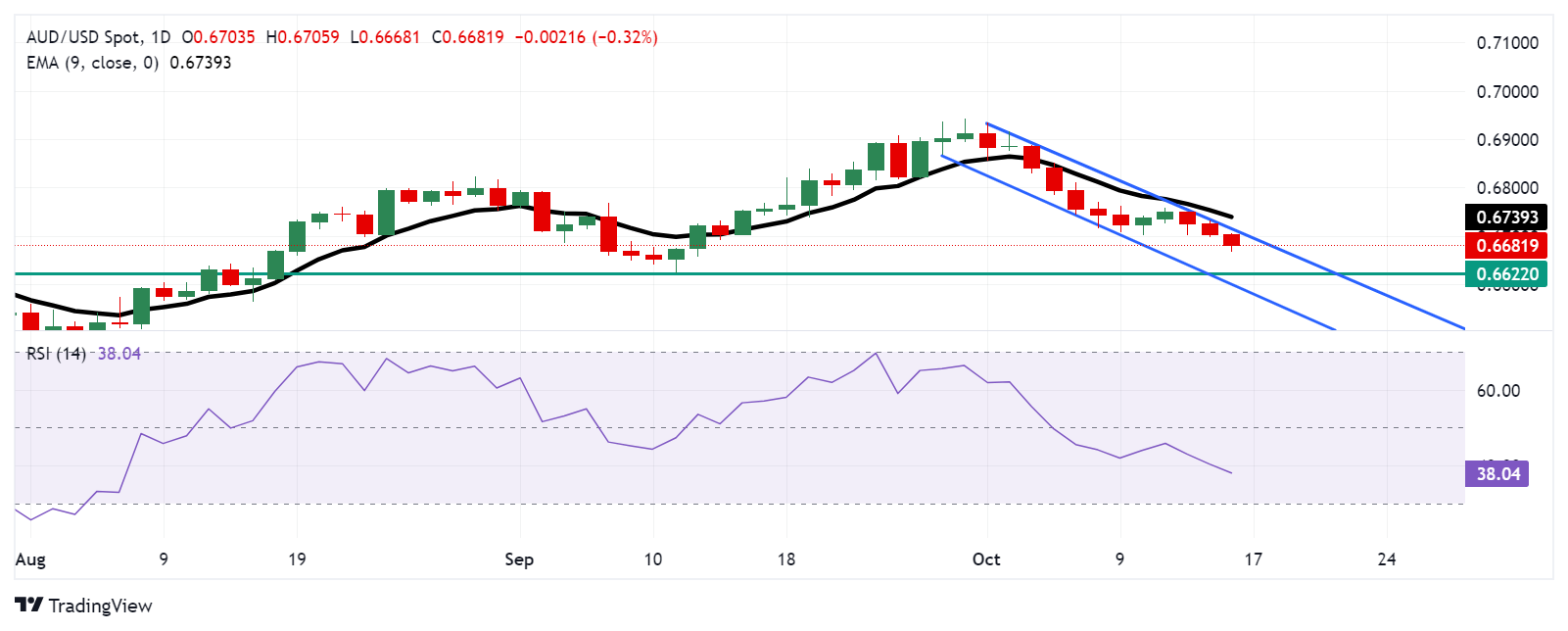- The Australian dollar extends its losing streak due to economic problems in China.
- The RBA’s Hunter said that while inflation expectations remain anchored, persistent price growth continues to present challenges for the central bank.
- The US dollar appreciates as strong employment and inflation data have reduced the chances of aggressive easing by the Fed.
The Australian Dollar (AUD) extends its losing streak for the third consecutive day against the US Dollar (USD) on Wednesday, despite hawkish comments from Reserve Bank of Australia (RBA) Deputy Governor Sarah Hunter.
The RBA’s Hunter reaffirmed the Australian central bank’s commitment to taming inflation, noting that while inflation expectations remain anchored, persistent price growth continues to pose challenges.
The Australian Dollar faces downward pressure due to economic uncertainty in its largest trading partner, China. Additionally, China’s recently announced fiscal stimulus plan did little to lift market sentiment as investors remain uncertain about the scale and impact of the package.
The US Dollar (USD) continues to gain support as strong employment and Consumer Price Index (CPI) data have reduced expectations of aggressive easing from the Federal Reserve (Fed). Markets now anticipate a total of 125 basis points in rate cuts over the next 12 months.
Daily Market Drivers Summary: Australian Dollar Struggles Due to Economic Uncertainty in China
- According to the CME FedWatch tool, there is currently a 94.1% chance of a 25 basis point rate cut in November, with no expectation of a reduction greater than 50 basis points.
- The Westpac Leading Index in Australia was unchanged in September on a month-on-month basis, marking the sixth consecutive month of stagnation.
- On Tuesday, Federal Reserve Bank of Atlanta President Raphael Bostic stated that he anticipates only one more 25 basis point interest rate cut this year, as reflected in his projections during the US central bank’s meeting. USA last month. “The median forecast was 50 basis points beyond the 50 basis points already implemented in September. My projection was an additional 25 basis points,” he said, according to Reuters.
- Australia’s weekly consumer confidence survey showed little movement, with the ANZ-Roy Morgan Consumer Confidence Index holding steady at 83.4 this week. Despite the unchanged figure, the long-term trend shows that consumer confidence has been below the 85.0 mark for a record 89 consecutive weeks. The current reading is 1.3 points higher than the 2024 weekly average of 82.1.
- Minneapolis Federal Reserve Bank President Neel Kashkari reassured markets Monday night by reaffirming the Fed’s data-dependent approach. Kashkari reiterated the familiar views of policymakers of the Fed on the strength of the US economy, pointing to a continued decline in inflationary pressures and a robust labor market, despite a recent rise in the overall unemployment rate, according to Reuters.
- The AUD could have received downward pressure from a detailed note from the Commonwealth Bank of Australia indicating expectations that the Reserve Bank of Australia (RBA) will implement a 25 basis point rate cut by the end of 2024. The report suggested that a stronger disinflationary trend than the RBA anticipates is essential for the Board to consider easing policy within this calendar year.
- China’s military began exercises on Monday in the Taiwan Strait and around Taiwan. A spokesperson for the US State Department expressed serious concern about the military actions of the People’s Liberation Army (PLA). In response, Taiwan’s Ministry of Defense stated: “We will not escalate the conflict in our response.”
- China’s National Bureau of Statistics reported that the country’s monthly Consumer Price Index (CPI) was unchanged at 0% in September, down from a 0.4% increase in August. The annual inflation rate increased by 0.4%, below the anticipated 0.6%. Additionally, the Producer Price Index (PPI) decreased 2.8% year-on-year, a larger drop than the previous 1.8% decline and exceeding expectations for a 2.5% decline.
Technical Analysis: Australian Dollar moves below 0.6700; 14-day RSI reinforces ongoing bearish bias
The AUD/USD pair is around 0.6680 on Wednesday. Technical analysis of the daily chart indicates that the pair is moving down along the upper boundary of a descending channel, signaling a bearish bias. The 14-day Relative Strength Index (RSI) also remains below the 50 level, reinforcing the ongoing bearish momentum.
On the downside, the AUD/USD pair could target its eight-week low of 0.6622, last seen on September 11. A break below this level could open the door for the pair to test the lower boundary of the descending channel near the 0.6600 psychological support level.
In terms of resistance, if the pair breaks above the upper boundary of the descending channel at the 0.6720 level, it could face an initial barrier at the nine-day exponential moving average (EMA) around 0.6738, followed by the key psychological resistance at 0.6800.
AUD/USD: Daily Chart
Australian Dollar PRICE Today
The table below shows the percentage change of the Australian Dollar (AUD) against major currencies today. Australian dollar was the weakest currency against the Japanese yen.
| USD | EUR | GBP | JPY | CAD | AUD | NZD | CHF | |
|---|---|---|---|---|---|---|---|---|
| USD | 0.03% | 0.04% | -0.10% | 0.05% | 0.30% | 0.43% | -0.03% | |
| EUR | -0.03% | 0.02% | -0.11% | 0.04% | 0.28% | 0.43% | -0.09% | |
| GBP | -0.04% | -0.02% | -0.16% | 0.03% | 0.26% | 0.40% | -0.06% | |
| JPY | 0.10% | 0.11% | 0.16% | 0.17% | 0.41% | 0.54% | 0.11% | |
| CAD | -0.05% | -0.04% | -0.03% | -0.17% | 0.23% | 0.37% | -0.08% | |
| AUD | -0.30% | -0.28% | -0.26% | -0.41% | -0.23% | 0.14% | -0.32% | |
| NZD | -0.43% | -0.43% | -0.40% | -0.54% | -0.37% | -0.14% | -0.47% | |
| CHF | 0.03% | 0.09% | 0.06% | -0.11% | 0.08% | 0.32% | 0.47% |
The heat map shows percentage changes for major currencies. The base currency is selected from the left column, while the quote currency is selected from the top row. For example, if you choose the Australian Dollar from the left column and move along the horizontal line to the US Dollar, the percentage change shown in the box will represent the AUD (base)/USD (quote).
The Australian Dollar FAQs
One of the most important factors for the Australian Dollar (AUD) is the level of interest rates set by the Reserve Bank of Australia (RBA). As Australia is a resource-rich country, another key factor is the price of its largest export, iron ore. The health of the Chinese economy, its largest trading partner, is a factor, as is inflation in Australia, its growth rate and the Balance of Trade. Market sentiment, that is, whether investors bet on riskier assets (risk-on) or seek safe havens (risk-off), is also a factor, with the risk-on being positive for the AUD.
The Reserve Bank of Australia (RBA) influences the Australian Dollar (AUD) by setting the level of interest rates that Australian banks can lend to each other. This influences the level of interest rates in the economy as a whole. The RBA’s main objective is to maintain a stable inflation rate of 2%-3% by adjusting interest rates up or down. Relatively high interest rates compared to other major central banks support the AUD, and the opposite for relatively low ones. The RBA can also use quantitative easing and tightening to influence credit conditions, with the former being negative for the AUD and the latter being positive for the AUD.
China is Australia’s largest trading partner, so the health of the Chinese economy greatly influences the value of the Australian Dollar (AUD). When the Chinese economy is doing well, it buys more raw materials, goods and services from Australia, which increases demand for the AUD and drives up its value. The opposite occurs when the Chinese economy does not grow as fast as expected. Therefore, positive or negative surprises in Chinese growth data usually have a direct impact on the Australian Dollar.
Iron ore is Australia’s largest export, with $118 billion a year according to 2021 data, with China being its main destination. The iron ore price, therefore, may be a driver of the Australian dollar. Typically, if the price of iron ore rises, the AUD also rises as aggregate demand for the currency increases. The opposite occurs when the price of iron ore falls. Higher iron ore prices also tend to result in a higher likelihood of a positive trade balance for Australia, which is also positive for the AUD.
The trade balance, which is the difference between what a country earns from its exports and what it pays for its imports, is another factor that can influence the value of the Australian dollar. If Australia produces highly sought-after exports, its currency will gain value solely from the excess demand created by foreign buyers wanting to purchase its exports versus what it spends on purchasing imports. Therefore, a positive net trade balance strengthens the AUD, with the opposite effect if the trade balance is negative.
Source: Fx Street
I am Joshua Winder, a senior-level journalist and editor at World Stock Market. I specialize in covering news related to the stock market and economic trends. With more than 8 years of experience in this field, I have become an expert in financial reporting.








